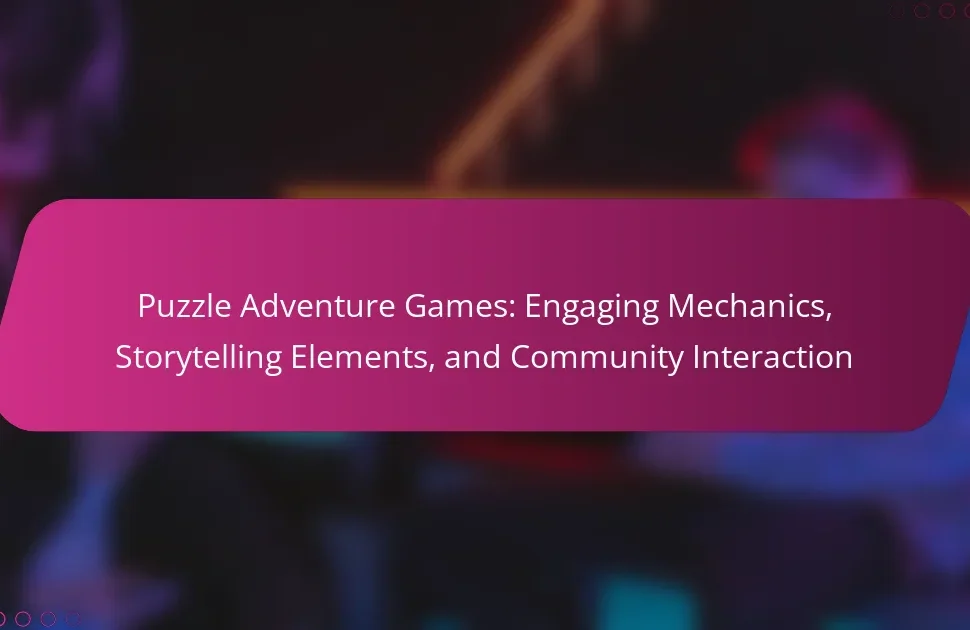Puzzle adventure games have evolved to meet player expectations and technological advancements. This article explores the evolution of gameplay mechanics, design trends, and changing player preferences. It highlights the shift towards immersive storytelling, adaptive challenges, and cooperative gameplay. Additionally, it examines how developers balance complexity and accessibility to create engaging experiences.

How have puzzle adventure games evolved over the years?
Puzzle adventure games have significantly evolved, adapting to player preferences and technological advancements. Early titles focused on simple mechanics and linear narratives, while modern games incorporate complex puzzles, open-world exploration, and rich storytelling.
The design trends have shifted from pixel art to high-definition graphics, enhancing immersion. Developers now prioritize user experience, integrating intuitive controls and adaptive difficulty levels.
Player preferences have changed towards cooperative gameplay and social interaction, leading to multiplayer puzzle adventures. This evolution reflects a broader trend towards community-driven experiences and shared problem-solving.
Overall, the evolution of puzzle adventure games showcases a blend of innovation in gameplay mechanics, design aesthetics, and a deeper understanding of player engagement.
What are the key milestones in the genre’s development?
Puzzle adventure games have evolved through significant milestones that shaped their gameplay and design. Key milestones include the introduction of text-based adventures in the late 1970s, which emphasized narrative and problem-solving. In the 1980s, graphical adventure games emerged, enhancing visual storytelling and player immersion. The 1990s saw the rise of 3D environments, allowing for more complex puzzles and exploration. The early 2000s introduced hybrid mechanics, blending puzzle-solving with action elements, catering to diverse player preferences. Recent trends focus on mobile platforms and interactive storytelling, appealing to a broader audience.
How have gameplay mechanics changed from classic to modern titles?
Gameplay mechanics in puzzle adventure games have shifted from simple, linear challenges to complex, multi-layered experiences. Modern titles incorporate advanced technology, allowing for richer narratives and interactive environments.
Classic games often relied on static puzzles and straightforward progression. In contrast, contemporary designs utilize dynamic storytelling, player choice, and immersive graphics. This evolution enhances engagement and caters to diverse player preferences.
Additionally, modern games emphasize cooperative gameplay and online interactions. These features promote social play, contrasting with the solitary experiences typical of classic puzzle adventures.
Overall, the transition reflects a broader trend towards deeper immersion and interactivity in gaming, aligning with changing player expectations.
What role do technological advancements play in this evolution?
Technological advancements significantly enhance gameplay, design trends, and player preferences in puzzle adventure games. Improved graphics and processing power create immersive environments, engaging players more deeply. Online connectivity fosters community interaction, enabling collaborative problem-solving. Additionally, advancements in artificial intelligence personalize experiences, adapting challenges to individual player skills. Enhanced user interfaces streamline navigation, making games more accessible. Virtual and augmented reality introduce innovative gameplay mechanics, transforming traditional puzzle-solving into interactive experiences.

What design trends are shaping the future of puzzle adventure games?
Puzzle adventure games are evolving through innovative design trends that enhance player engagement. Key trends include immersive storytelling, which deepens emotional connections; environmental puzzles that leverage interactive surroundings; and adaptive difficulty, tailoring challenges to player skill levels. Additionally, the integration of multiplayer elements fosters collaboration, while aesthetic styles, such as retro and minimalist designs, appeal to diverse player preferences. These trends collectively shape the future of puzzle adventure games, creating richer and more dynamic gaming experiences.
Which art styles are currently popular among developers and players?
Puzzle adventure games currently feature vibrant, stylized graphics and immersive storytelling, appealing to both developers and players. Popular art styles include hand-drawn aesthetics, pixel art, and 3D low-poly designs. These styles enhance engagement and foster creativity, aligning with player preferences for unique visual experiences. Additionally, the use of color palettes and dynamic lighting effects contributes to the overall atmosphere, making games visually captivating.
How do sound design and music enhance the gaming experience?
Sound design and music significantly enhance the gaming experience by immersing players in the game world. They create emotional connections, set the tone, and provide cues for gameplay mechanics.
In puzzle adventure games, sound effects guide players through challenges, while music evolves with gameplay to reflect tension or resolution. This dynamic interaction keeps players engaged and heightens satisfaction upon solving puzzles.
Moreover, unique soundscapes can differentiate a game, making it memorable. For instance, a distinctive soundtrack can become synonymous with a game’s identity, influencing player preferences and enhancing replay value.
Overall, effective sound design and music are essential in shaping player experiences and fostering deeper connections with puzzle adventure games.
What are the emerging narrative techniques in puzzle adventure games?
Emerging narrative techniques in puzzle adventure games include branching storylines, environmental storytelling, and interactive dialogue systems. These techniques enhance player engagement and create dynamic experiences.
Branching storylines allow players to make choices that affect the narrative outcome, fostering a sense of agency. Environmental storytelling uses visual cues and world-building to convey plot elements without explicit exposition. Interactive dialogue systems enable players to engage with characters, influencing relationships and plot development.
As a result, these techniques cater to diverse player preferences, offering varied gameplay experiences. They reflect a shift towards player-driven narratives, enhancing immersion and replayability in puzzle adventure games.

How do player preferences influence game design in this genre?
Player preferences significantly shape the design of puzzle adventure games by influencing mechanics, narrative, and difficulty levels. Developers analyze player feedback to create engaging experiences that align with player expectations. Trends show a shift towards more immersive storytelling and adaptive challenges that cater to diverse skill levels. Unique attributes, such as customizable puzzles and interactive environments, enhance player satisfaction and prolong engagement. As a result, player preferences drive innovation and evolution in game design, ensuring relevance in a competitive market.
What psychological factors drive player engagement in puzzle adventures?
Psychological factors that drive player engagement in puzzle adventures include challenge, curiosity, and reward. Players are motivated by the desire to solve complex problems, which enhances their sense of achievement. Curiosity about the storyline and game mechanics fosters deeper involvement. Additionally, reward systems, such as unlocking new levels or obtaining achievements, reinforce continued play. These elements create a compelling experience that keeps players invested in puzzle adventure games.
Which demographics are most drawn to puzzle adventure games?
Puzzle adventure games attract a diverse audience, primarily aged 18 to 34. This demographic values immersive storytelling and problem-solving elements. Additionally, players often include casual gamers seeking engaging experiences without extensive time commitment. The rise of mobile platforms has further expanded accessibility, drawing in various age groups. Female players represent a significant portion, reflecting broader trends in gaming inclusivity.
How do cultural differences affect player preferences in various regions?
Cultural differences significantly influence player preferences in puzzle adventure games. Players from various regions exhibit distinct tastes shaped by their cultural backgrounds, values, and gaming experiences.
For instance, players in Western cultures often prefer narrative-driven gameplay that emphasizes story and character development. In contrast, players from Eastern cultures may favor gameplay that includes collaborative elements and social interactions.
Additionally, design trends reflect these preferences. Western games frequently showcase intricate graphics and immersive worlds, while Eastern games may prioritize simplicity and accessibility.
Understanding these cultural nuances helps developers tailor their games to meet diverse player expectations, enhancing overall engagement and satisfaction.

What are the core gameplay mechanics that define puzzle adventure games?
Puzzle adventure games are defined by core gameplay mechanics such as exploration, puzzle-solving, and narrative engagement. Players navigate environments while interacting with objects and characters to uncover clues and solve challenges.
These mechanics foster critical thinking and creativity, requiring players to analyze their surroundings and apply logic. The integration of story elements enhances immersion, making player choices impactful. Unique attributes include diverse puzzle types, varying difficulty levels, and artistic styles that cater to different player preferences.
As a result, puzzle adventure games continue to evolve, incorporating innovative design trends that appeal to both casual and hardcore gamers.
How do puzzles integrate with storytelling in these games?
Puzzle adventure games effectively integrate puzzles into storytelling by using them as narrative devices that enhance player engagement. Puzzles often reveal plot elements, character backgrounds, or world lore, making players feel more immersed in the game. For instance, solving a puzzle might unlock a new area or provide crucial information that drives the story forward. This design trend fosters a deeper connection between gameplay and narrative, allowing players to influence the story through their problem-solving skills. Furthermore, player preferences have shifted towards games that balance challenging puzzles with storytelling, creating a richer gaming experience.
What is the importance of exploration in puzzle adventure gameplay?
Exploration is crucial in puzzle adventure gameplay as it enhances immersion and engagement. Players uncover narrative elements and environmental storytelling through exploration, which deepens their connection to the game world. Additionally, exploration encourages problem-solving and critical thinking, as players must navigate challenges and discover hidden clues. This dynamic fosters a sense of achievement and satisfaction, making exploration a key component of player enjoyment in puzzle adventure games.

Which unique features set apart the best puzzle adventure games?
The best puzzle adventure games stand out due to their immersive storytelling, innovative mechanics, and unique art styles. These features enhance player engagement and create memorable experiences. Notable examples include intricate puzzles that require critical thinking and exploration, combined with captivating narratives that unfold as players progress. Unique attributes such as dynamic environments and character interactions further differentiate these games, offering players a rich and varied gameplay experience.
What innovative gameplay elements have been introduced in recent titles?
Recent puzzle adventure games have introduced innovative gameplay elements such as environmental interaction, dynamic puzzles, and narrative-driven mechanics. These features enhance player engagement and challenge traditional gameplay structures. For example, some titles incorporate real-time decision-making that affects puzzle outcomes and story progression. Additionally, augmented reality elements are increasingly utilized, blending physical and digital experiences. These advancements reflect evolving design trends and player preferences for immersive, interactive gameplay.
How do user-generated content and community involvement enhance the experience?
User-generated content and community involvement significantly enhance the experience of puzzle adventure games. Players contribute strategies, solutions, and creative ideas, enriching gameplay. Community forums foster collaboration and social interaction, increasing player engagement. Unique user-generated puzzles offer fresh challenges, while feedback shapes game design, aligning with player preferences. This interaction cultivates a vibrant ecosystem that keeps the gaming experience dynamic and evolving.

What challenges do developers face in creating engaging puzzle adventure games?
Developers face significant challenges in creating engaging puzzle adventure games, including balancing complexity and accessibility. They must ensure puzzles are challenging yet solvable, catering to diverse player skill levels. Additionally, maintaining narrative coherence while integrating puzzles can be difficult, as players expect a seamless experience. The evolving design trends push developers to innovate constantly, which can strain resources and timelines. Lastly, understanding player preferences is crucial, as tastes change, requiring ongoing research and adaptation to keep the game appealing.
How do balancing difficulty and accessibility impact player satisfaction?
Balancing difficulty and accessibility enhances player satisfaction by providing a challenging yet achievable experience. Puzzle adventure games must engage players without causing frustration. A well-tuned difficulty curve allows players to feel a sense of accomplishment while maintaining accessibility ensures that a wider audience can enjoy the game.
Games that offer adjustable difficulty settings cater to diverse player preferences, accommodating both casual and hardcore gamers. For example, a game might include hints or tutorials for beginners while providing complex puzzles for experienced players. This dual approach fosters inclusivity and encourages longer play sessions.
Moreover, player feedback often emphasizes the importance of these factors. Games that fail to strike a balance may see increased player dropout rates. Developers are increasingly recognizing that thoughtful design choices in difficulty and accessibility directly correlate with player retention and satisfaction.
In summary, the interplay of balancing difficulty and accessibility is crucial in puzzle adventure games, ultimately leading to a more satisfying gaming experience for players of all skill levels.
What common pitfalls should developers avoid in game design?
Developers should avoid common pitfalls like overcomplicating mechanics, neglecting player feedback, and ignoring pacing. Simplifying gameplay enhances player experience. Failing to incorporate feedback can lead to disengagement. Additionally, inconsistent pacing disrupts immersion, making it crucial to maintain balance throughout the game.

What are the best practices for maximizing player engagement in puzzle adventure games?
To maximize player engagement in puzzle adventure games, developers should focus on immersive storytelling, intuitive controls, and rewarding progression systems. Engaging narratives keep players invested, while user-friendly mechanics enhance accessibility. Incorporating varied puzzles and challenges maintains interest, and regular updates with new content can foster a loyal player base. Additionally, community feedback should guide design choices to align with player preferences, ensuring a dynamic gaming experience.
How can developers effectively incorporate feedback from players?
Developers can effectively incorporate player feedback by actively engaging with their community, analyzing feedback trends, and implementing changes based on player preferences. Regular updates and open communication channels foster a collaborative environment.
Utilizing surveys and forums allows developers to gather insights on gameplay mechanics, design elements, and overall player satisfaction. Prioritizing feedback based on player impact ensures that the most significant issues are addressed first.
As a result, incorporating player feedback leads to improved gameplay experiences, aligning design trends with player expectations. This iterative development process solidifies player loyalty and enhances the game’s longevity.
What strategies can enhance the replayability of puzzle adventure games?
Implementing diverse gameplay mechanics, dynamic environments, and player-driven narratives can significantly enhance the replayability of puzzle adventure games. Incorporating procedurally generated levels fosters unique experiences, while offering multiple solutions to puzzles caters to varied player strategies. Regular content updates and community-driven challenges keep players engaged over time. Additionally, integrating cooperative multiplayer modes can create shared experiences, further increasing replay value.




